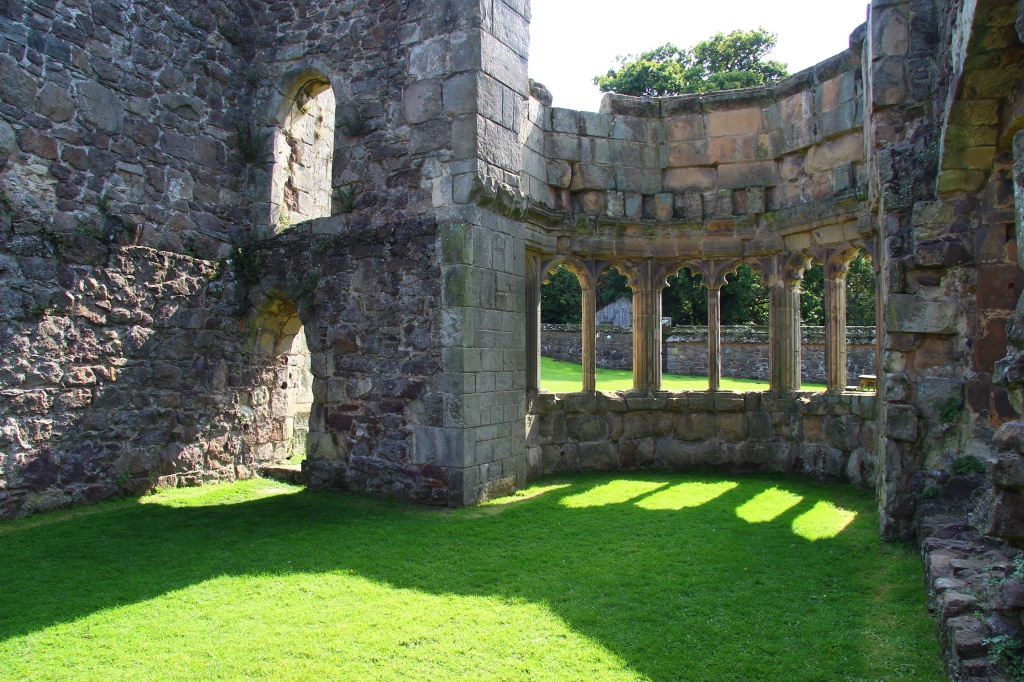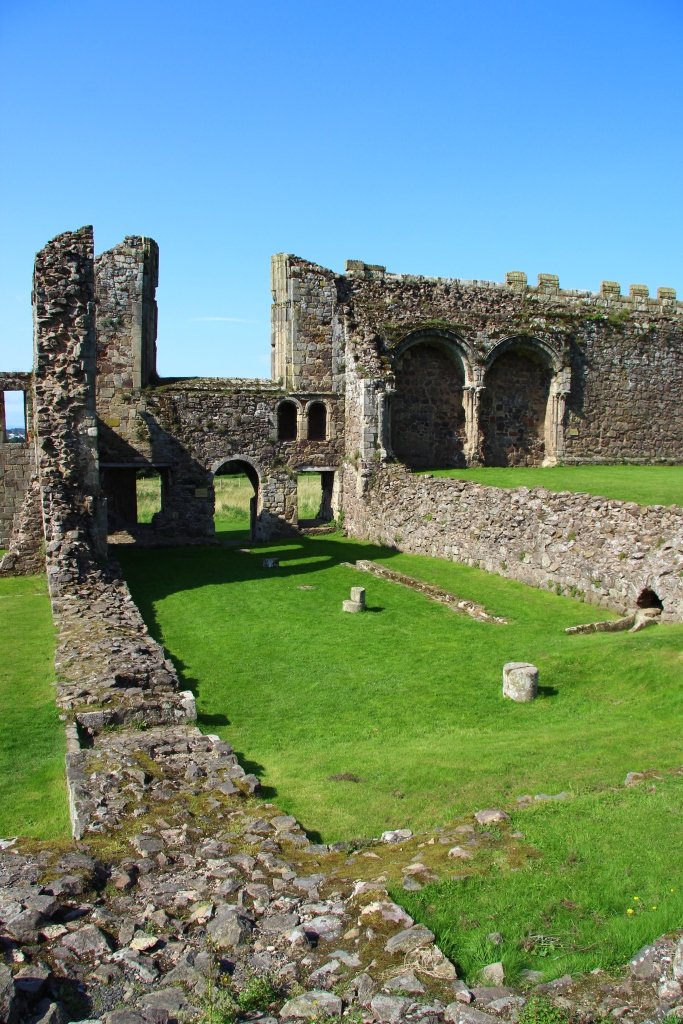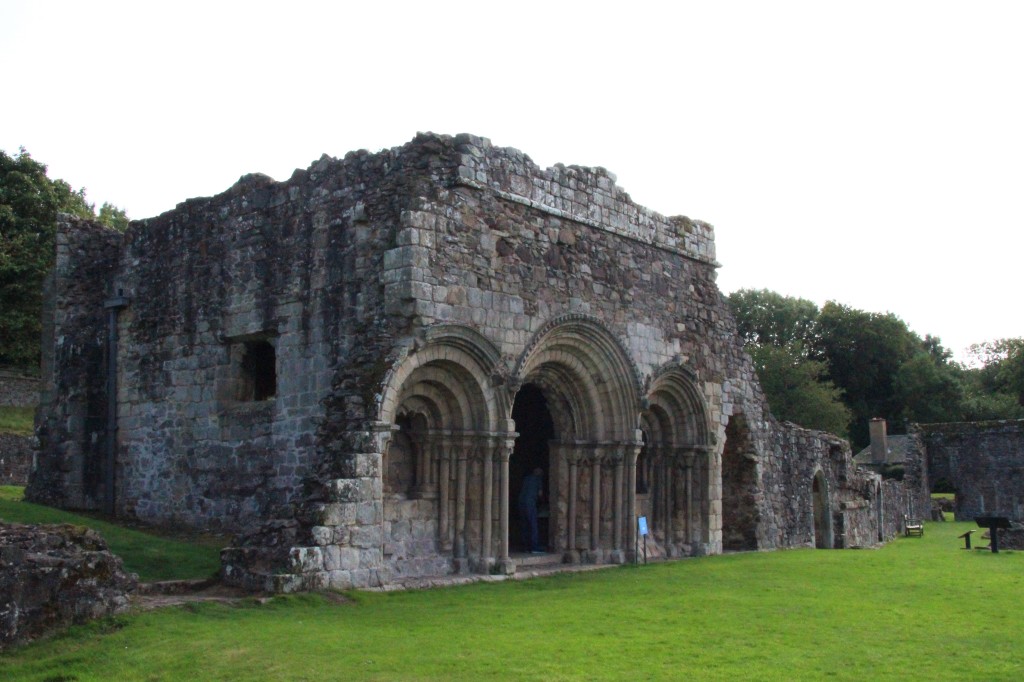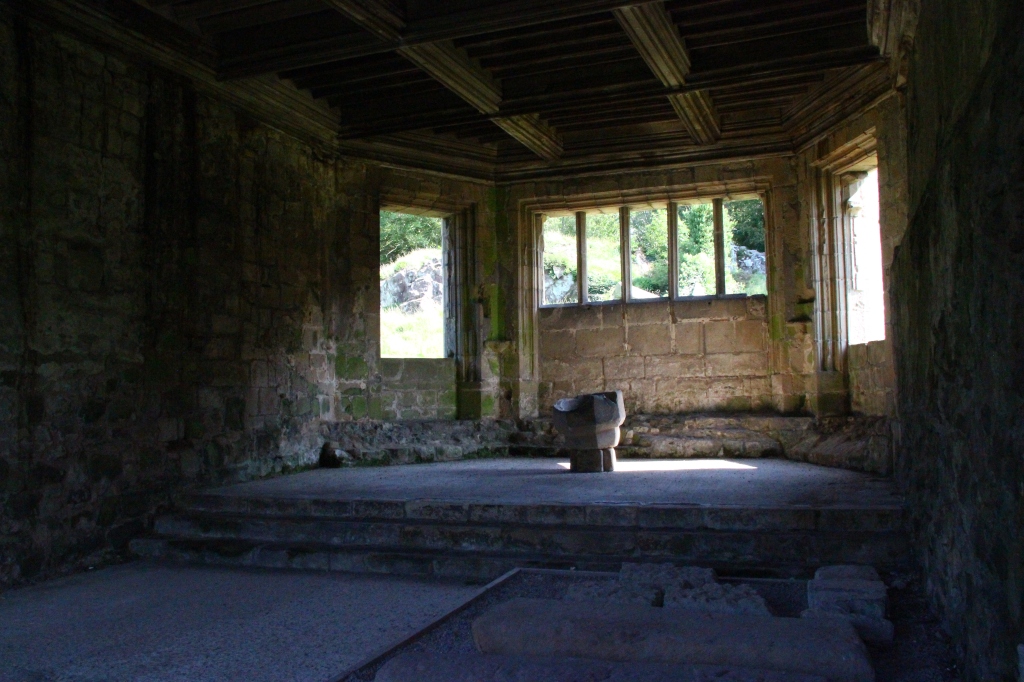Over the summer I’ve been trying to make up for lost time by getting out to as many medieval sites as possible to physically reconnect with the past. Last weekend I fancied a bit of an adventure, so we set off on a journey to deepest Shropshire to explore the extensive ruins of a rather beautiful abbey. It was a trip well worthwhile, because whilst being bathed in some glorious early autumn sunshine I got to connect with a vital part of the medieval world. So come and join me on a wander of discovery around a rather splendid place, and peer through a window into another world of prayer, austerity, and for some, great luxury.

Back in the Middle Ages again, and happy…
Situated on a rocky hillside near Shrewsbury between the Roden and the Upper Severn rivers, Haughmond Abbey can trace its roots back to the 11th Century, when the remote and then thickly wooded rural site attracted a group of hermits keen to escape from the world (I know how they felt). In the twelfth century the community benefitted from the patronage of two local nobles, William FitzAlan and John Lestrange, both powerful marcher lords defending the Anglo-Welsh border for the English crown. Religion was central to life in the Middle Ages, and the fear of one’s immortal soul spending an eternity in purgatory – or worse – drove wealthy people to invest in religious institutions as insurance for the afterlife. The way to do that was to support, enhance, or even to found an abbey or monastery whose inhabitants would pray for your soul and secure your place on the right side of the pearly gates.
After 1130, the community at Haughmond adopted the Augustinian Rule, which meant that strictly speaking they were canons rather than monks. Unlike monks, canons were all priests. They went out into the wider community rather than being an entirely closed order, and they lived less austere lives than some religious houses. For instance, they didn’t believe in wearing scratchy woollen clothing like other monastic orders, so instead they wore linen, a cassock lined with sheepskin or fur for warmth and a distinctive long, black hooded outer cope, earning them the name of ‘Black Canons’.

The Augustinian canon in his characteristic black cope
Although they lived similar lives to monks and were also bound by the rules of poverty, chastity and obedience they weren’t as heavily tied to manual labour, which freed up more time to serve the parishes granted to them by their patrons. They would go out singularly or in pairs to administer the sacraments, preach, teach and tend to the sick and needy. Hospitality for all was another key function for Augustinian canons, and they welcomed guests, pilgrims and travelers as well as caring for the sick. By 1153, the increasingly prosperous canons had assumed the title of abbey, and their house was to be extended and embellished over the following centuries.
The head of the house, the ‘big brother’ if you like, was the abbot. His word was law, but running a community of men under a strict religious rule was no easy task. As well as managing financial matters and estate business, he had to balance fair leadership with discipline and deal with the monks’ self-doubt and crises of faith. He was also expected to entertain important guests and even royalty in a fitting manner, so with all these burdens he needed somewhere to chill out and somewhere to show off. This suite of luxury apartments is our first taste of Haughmond, so welcome to the abbot’s withdrawing chambers and his rather impressive great hall.

Entrance to the Abbey today is through the abbot’s plush rooms
Set over two floors, these comfortable rooms were where the abbot could retreat from his stessful job and relax or meet with important guests. It would have been richly furnished with colourful fabrics, and the large fireplace and fabulously ornate bay window more than hint at the level of splendour he enjoyed. Through a doorway we enter the abbot’s great hall, which is so imposing it could rival that of a castle. The tall, ornate windows would have lit the scene of formal dinners, with the abbot seated on a raised dais at the end nearest his chambers while junior members of the household sat at tables placed along the walls. Guests entered, as did the food and drink, through an internal passage behind a wooden partition at the far end of the hall beneath another vast window, and the whole of the grand room was covered with an open timber roof. In fact, this room was so similar to its castle counterpart that after the dissolution of the monasteries in the 16th Century it was used without any alteration as the great hall for a fine secular residence.

The abbot’s withdrawing chambers with the magnificent window
and big fireplace on the right…

…and his impressive great hall for formal dining and entertaining
important guests

A rare treat: surviving medieval floor tiles outside the entrance
to the abbot’s great hall
Next we find the kitchen with its substantial fireplaces for the preparation of all the food required by the house and their guests. This is one of several domestic buildings surrounding a courtyard, the opposite side of which houses the dormitory, a long first floor room where the canons slept. I say ‘slept’, but if you’d been a canon, you’d have been turfed out of your bed by a rousing midnight bell – wearing full garb as it was forbidden to lie ‘immodestly’ because it attracted the devil – to attend the great service of Mattins, or Nocturns, followed by another service called Lauds. These formed part of the seven canonical ‘hours’, fixed times of prayer that had to be kept every day. Turning up late and falling asleep on the job were punishable offences, so drowsy canons would sometimes chew on peppercorns to keep themselves conscious, while anyone who did drift off would be rudely awakened by an official’s lantern being shone in his face. Even the loos were checked for craftily slumbering brothers. Then it was back to bed for another few hours’ kip before rising again for the next service, Prime, at 6.00am. So moving swiftly on from the thought of continually broken sleep, we come to the far side of the courtyard, and the refectory.

The kitchen with it’s massive fireplaces

An arched doorway led from the kitchen to the abbot’s great hall

The communal dormitory, where the canons slept (a bit)…
Built around 1180, this is where the canons took their two daily meals, seated at tables set out along the walls and being served from the centre. Accessed from the main cloister, the refectory was at first floor level, and everyone was expected to wash their hands before entering at the ‘Laver’. This was a series of basins fed by running water, often framed by stone arches in the walls. Meals were taken in silence to the sole sound of a devotional reading delivered from a side pulpit, but the brethren developed a sophisticated sign language to communicate with one another over dinner, leading one visitor to a similar house likening these mealtimes to a ‘dumb-show’!

The refectory, where the canons took their meals in silence

The arches that framed the Laver, where monks washed their hands before entering the refectory through a now vanished doorway on the left
The first, and main meal of the day came after the service of Sext at noon and usually consisted of two cooked dishes and a third of fruit. Being canons they ate reasonably well, with moderate consumption of meat and wine permitted, as long as it wasn’t on fasting days, and bread, fish, eggs, cheese and vegetables also featured in their diet. If you were poorly, you were allowed extra meat, but feigning illness to get it was another punishable offence. Supper was a lighter affair taken after Evensong at 5.00pm, and following a brief period of relaxation and perhaps some ale the last service of the day, Compline, was said around 8.00pm before bedtime around 9.00pm.
Although the Augstinian canons were busy for much of their day (and night) at prayer, study and quiet contemplation, they managed to fit in many other occupations such as writing or illuminating books, making their own garments, giving hospitality, carving, painting and other good works. There would have been little time to be bored.

Looking across the main cloister to a beautifully carved doorway
that once led to the abbey church
Beyond the Refectory is the main cloister, which formed the heart of the abbey and around which all the main monastic buildings were arranged. To the right is the superb Chapter House, with its stunning finely carved arches. This is where the canons would meet each day to discuss business following an opening formal reading from a chapter of the rule of the monastery, hence the building’s name.

The Chapter House with its elaborately carved arches

The interior of the Chapter House

The fine arches and their 14th Century carvings of saints

A collection of 13th and 14th Century grave slabs from the abbey site
are on show in the Chapter House
Across the far side of the cloister lie the remains of the most important building, the large abbey church, to which the public had access. Sadly, Henry VIII did a particularly thorough job of pulling down this part of the abbey when he dissolved it in 1539, so only the footings and outlines of the building remain.

All that remains of the great abbey church. Well done, Henry…
Today, the extensive ruins of Haughmond Abbey are still tucked away in a peaceful rural setting, and I thoroughly enjoyed wandering around the former house of medieval canons and abbots who once walked the cloisters. But their regulated lives, even if not as austere as other monastic orders, wouldn’t have suited me. I’d never have made a canoness. I’d have been constantly dozing off during Nocturns and sneaking out to the tavern for a good drink and a natter. And as for the rule of chastity; forget it. Nevertheless, their part of the medieval world was a fascinating one, and I left Haughmond with a real sense of the brethren who devoted their lives to the glory of God and to serving the wider community. So as the sun began to set on a rather special day we made our way back through the Shropshire countryside and headed for home. Via the tavern, of course.

That was a very entertaining post indeed my love, and very informative as always. They really did lead a interesting life and I’m sure the wine and ale compensated for the lack of sleep 😀
See! I didn’t say anything! 😀
LikeLiked by 1 person
Good, well done! Glad you enjoyed it and learned a bit too. It’s a great place. 🙂
LikeLiked by 1 person
😀
It was indeed, I really enjoyed the visit. It was a great place to wander around and relax. The Ale house was fun too!
LikeLiked by 1 person
The Tavern, please…
LikeLiked by 1 person
Woops! Of course, silly me – must be the drink! 😀
LikeLiked by 1 person
Hic… 😉
LikeLiked by 1 person
😀 Hic indeed!
LikeLiked by 1 person
That looks a great place to be. The tiles are particularly cool.
LikeLiked by 1 person
They are, aren’t they? In fact, I said at the time that the tiles are worth the journey alone. It is, indeed, a great place to be. Thanks for joining me, Kev.
LikeLiked by 1 person
Excellent introduction to the lives of the Canons, great to imagine the Abbey in its original glory.
LikeLiked by 1 person
Thanks Bobby, glad you enjoyed meeting the medieval canons. When I was there, I couldn’t help but rebuild the place in my imagination, and I’m certain it was wonderful. 🙂
LikeLiked by 1 person
Another really great post and superb photos – cheered me up a lot – I’ve been pretty grumpy and overworked of late!
That looks a beautiful abbey and has some parts, like the bay window and that doorway, in really good condition. The old tiles are a great find too.
We loved Shropshire on our single visit but I found the drive to it from Yorkshire was pretty awful and it’s put me off driving down there again. Might consider going on the train or something though. We never got to ‘The Stiper Stones’ so we’d like another visit really… Maybe the drive is better from Cumbria – I ought to have a look…
LikeLiked by 1 person
Thanks Carol. I’m glad you enjoyed it, particularly if it cheered you up. Sorry to hear you’ve been overworked and low lately. At least you’ve got Eskdale to look forward to now.
It is a really beautiful abbey and it’s well worth a visit if you do get down that way again. There’s a lot to see in Shropshire, including one of my favourite castles – Ludlow. Maybe you will find a better route from Cumbria, but I know what you mean. It’s the same from here if we want to go out Cambridge or Suffolk way, the drive is a real pain.
Take care and hope things improve for you soon. 🙂
LikeLiked by 1 person
Love the photos and how intact parts of the buildings still remain. It is so interesting to learn about this lifestyle, and with the photos, easier to imagine. You look so happy in your element, too! That makes me smile 🙂 . Another great post, Alli!
LikeLiked by 1 person
Thanks Robyn! Glad to have made you smile, and to have opened a window for you on medieval abbey life. It’s another world, but an interesting one. 🙂
LikeLiked by 1 person
That was fascinating. I enjoyed the read . Some of the window shapes are lovely. The buildings must have been beautiful in the past. Your hair looks good dark. It suits you.
LikeLiked by 1 person
Thanks, Suzanne! I’ve been blonde for years so I fancied a change, and I decided that dark hair would look more medieval, but I’m glad you think it suits me. Glad you enjoyed reading about life for the canons at Haughmond. When you’re there, you can really appreciate just how imposing the buildings once were. It’s a special place. 🙂
LikeLiked by 1 person
It would be a great place to visit. I like your take on medieval hair colour. 😊
LikeLiked by 1 person
Thanks Suzanne! 🙂
LikeLike
Glad to see you are getting out and about. Fascinating as always.
LikeLiked by 1 person
Thanks John, glad you found it interesting. 🙂
LikeLiked by 1 person
Once again you’ve painted a fabulous picture of life in another wonderful old building, and your photographs capture it perfectly (or are they Stuart’s)?
Shropshire is a county I like a lot, but haven’t been there nowhere often enough, and I’ve never been to Haughmond Abbey. Thanks again Alli for transporting me away to another world yet again 🙂
LikeLiked by 2 people
Thanks again for the kind praise, Malc, and I’m glad to have taken you around another interesting place in my medieval world again.
Haughmond is well worth a visit if you’re in the area. In fact, there’s quite a bit to see in Shropshire. One of my favourite castles is Ludlow, which I’m hoping to get back to before too long. Fingers crossed, anyway. And, for once, most of the pictures are mine! 😀
LikeLiked by 1 person
I agree that Ludlow is really worth visiting and I hope you can manage to get back there before too long. It’s a long time since I’ve been there, and the town’s lovely too isn’t it?
Strangely enough, my current blog is about an old building and men of the cloth. You could have been there as well 🙂
LikeLiked by 1 person
I’m intrigued – great mind thinking alike again! Looking forward to it.
Yes, I’m very fond of Ludlow town too – not least because the castle still dominates it, of course, but it’s got so much character and history to it as well. 🙂
LikeLiked by 1 person
Both the place and the ruins begin with W 🙂
LikeLiked by 1 person
Hmmm, I’ll ponder on that, then. 🙂
LikeLiked by 1 person
One more clue. The place and ruin start with the same letter but are not the same word, and I know for a fact that you’ve been to the place, if not the ruin. Oops that’s two clues 🙂
LikeLiked by 1 person
Ah, that sort-of suggests somewhere, and if it’s where I’m think I haven’t been to the place you’re writing about. So I’m looking forward to it even more now! 🙂
LikeLiked by 1 person
mmm… You got me thinking now as to whether you know where it is 🙂
LikeLiked by 1 person
Me too… 🙂
LikeLiked by 1 person
It’s building up nicely to a big anti-climax now 🙂
LikeLiked by 1 person
Of course it’s not! Wherever it is, I’m sure I’ll love it. 🙂
LikeLiked by 1 person
I’d better get on with it then 🙂 I really enjoyed that post again. Thank you
LikeLiked by 1 person
You’re always welcome. 🙂
LikeLiked by 1 person
🙂
LikeLike
Really interesting post and the photographs are simply splendid .
LikeLiked by 1 person
Glad you enjoyed it, and that you liked the photos. It was a particularly glorious day.
LikeLike
Once again a lovely evocative post. Looks like you had a great day for it, loved the photos. The interupted sleep I could probably cope with (bit like the watch system on a boat), not sure about the whole eating in silence bit – quaffing and reverly or at least a good chat is what meals are for.
LikeLiked by 1 person
Thanks, Graham, I’m really pleased you enjoyed it. When I was writing about their interrupted sleep I was reminded of the ‘four hours’ lifestyle of sailors, and I agree entirely about what meals are for. I guess they just did a lot of waving around and gesticulating to one another instead – but it’s not the same. 😉 And I’d have wanted some good medieval music too. Thanks for reading. 🙂
LikeLike
A very interesting post (as usual), Alli. Thanks for outlining the differences between monks and canons. I thoroughly enjoyed your vivid descriptions of the building and daily life as you took me around this beautiful abbey. I do however prefer the title ‘grand pooh-bah’ to your ‘big brother’!
LikeLiked by 1 person
Thanks, Albert, glad you enjoyed my wander around Haughmond. It’s a fascinating and beautiful place. 🙂
LikeLiked by 1 person
As you write so well about medieval life and places I feel I should recommend a visit to Geddington church, Northamptonshire, a marvel of Saxon/medieval/ pre-Victorian desecration and a wealth of Plantagenet and medieval history coupled with enigmatic artefacts, well worth a visit and tour if you can get one
LikeLiked by 1 person
Thanks, Bobby, that’s a lovely thing to say. Funnily enough, Geddington Church is a place I’m keen to get to. I did a post on the Eleanor Crosses last year but didn’t get a chance to go in then, and at the moment I suspect, like too many other churches, it’s closed. However, thanks for the info and for reminding me of it, and I shall definitely put it at the top of my to-visit list. It sounds exactly the kind of place I’d love. 🙂
LikeLiked by 1 person
You can organise a visit with a brilliant guide if you contact geddingtonchurch@gmail.com he is excellent, look at trip advisor and you will see what I mean
LikeLiked by 1 person
Will do – thanks for the contact. Looking forward to it already! 🙂
LikeLike
Reblogged this on Serendipity Seeking Intelligent Life on Earth and commented:
Another great wander through the archaeology of the medieval years.
LikeLiked by 1 person